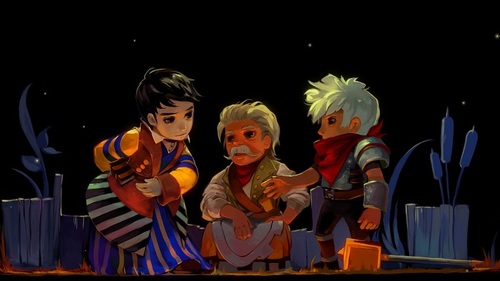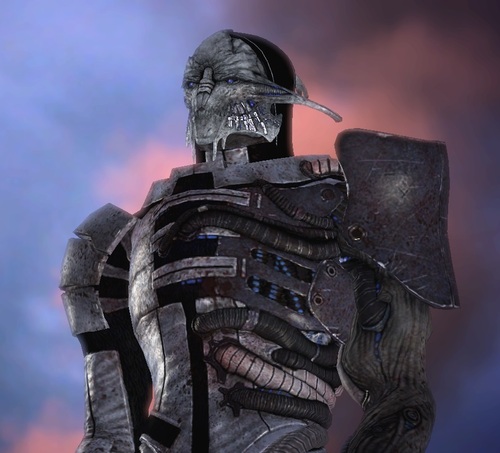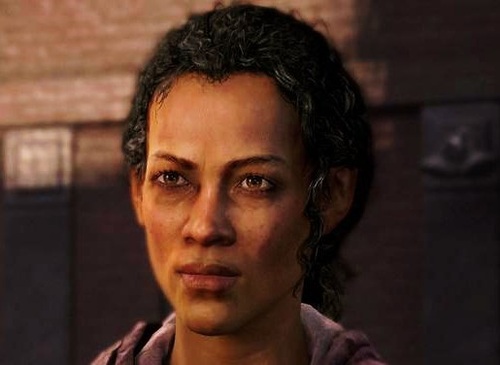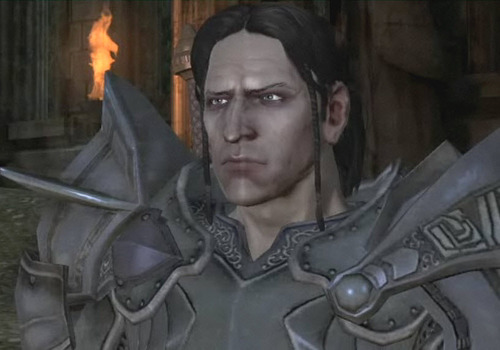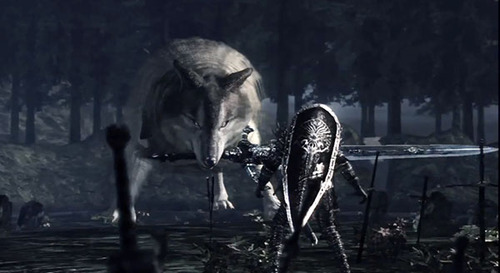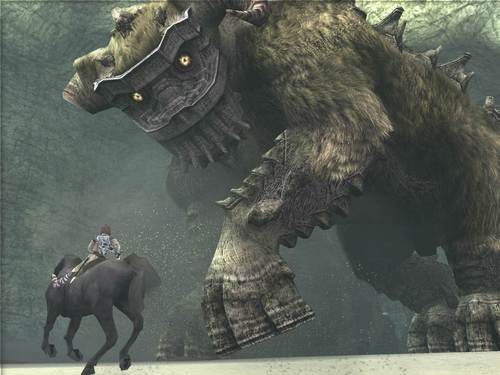It’s just not enough to be pure evil anymore. Outside of the occasionally well-written goofy villain (here’s lookin’ at you, Zinyak), developers of story-driven games have strived to create compelling and complex heroes and villains. Possibly the easiest way to create a worthwhile character is to make them relatable, not to a demographic, but as people with understandable motivations. For antagonists this often means that there’s a tragic past or a passionate belief in a certain ideology that edges them toward despicable acts. Here are 10 antagonists that are more victims of tragic circumstances than they are loathsome evildoers.
This list contains major spoilers for the following games: Bastion, Mass Effect, The Last of Us, Portal/Portal 2, Starcraft, Dragon Age: Origins, Metal Gear Solid 3: Snake Eater, Dark Souls, Papo & Yo and Shadow of the Colossus.
10. Zulf (Bastion)
Imagine you are young. Your parents died when you were a child and you’ve worked hard your entire existence getting by whatever you way you can. And now it feels like life is finally rewarding you for your troubles. You have killer sense of fashion; you’re deeply in love with someone who’s just accepted your marriage proposal. Things are finally looking up.
And then the Calamity. You wake up to find your city and the love of your life wiped away.
It’s clear that Zulf’s never been dealt a good hand, so it’s more than understandable when he turns against the player (“The Kid”) and sabotages their home after deciphering a journal and discovering that the The Kid’s race created the Calamity to destroy Zulf’s people. It’s not all bad, though. If the player chooses to forgive and rescue him at the end of the game, he’ll either join The Kid on a ship heading toward a new beginning or he’ll be reunited with his love when the world is reset to a pre-Calamity state (though there is no guarantee the Calamity won’t happen again, sadly).
9. Saren (Mass Effect)
Okay, okay, all things considered, Saren is a pretty terrible individual. He’s a ruthless Turian racist who would be happy to rid the universe of humans and ends up working with the Reapers to conquer the civilizations of the galaxy. However, Saren’s misguided actions (including horrific experiments on living beings) emerge from a genuine desire to save the people he’s sworn to protect. He chooses to serve the Reapers in order to prove that “organics” are worthwhile subjects; it’s a foolhardy mistake that results in his mind being indoctrinated by the Reapers, but it’s one that shows beneath that horrible mass of racism and violent tendencies, there is some honor there. This no more clearer than when, at the end of the game, if the player has enough Renegade/Paragon points, she can convince Saren to kill himself out of remorse and defiance. Poor Saren. If you had been just a bit smarter, you could have been a valuable ally.
8. Sarah Kerrigan (Starcraft)
Few videogame-related images are as frightening as the Queen of Blades staring at you with her withering gaze, but the core of that rage is actually a sad story of an abused, tortured soldier abandoned to a cruel fate for carrying out her duties. Kerrigan accidently killed her mother (and wounded her father) with her telekinetic powers when she was a child. The Terran government subjected her to cruel testing that eventually turned her into a capable assassin. As an adult, she forms a close friendship with Jim Raynor, a soldier turned rebel, and participates in a rebellion led by Arcturus Mengsk against The Terran Confederacy. Mengsk, partially out of revenge for Kerrigan assassinating his father, abandons her to be slaughtered by an army of Zerg.
Instead of killing her, the Zerg Overmind adopts her and turns her into The Queen of Blades, a fearsome half-Zerg, half-human entity of great power hell-bent on ruling the Zerg and killing Mengsk. Her lust for power and vengeance comes at a great cost, both in how many lives she ends and the toll it takes on her relationship with Raynor.
7. Marlene (The Last of Us)
The Last of Us is oddly refreshing in that there is no single villain hounding Joel and Ellie throughout the game. However, at the end, Marlene, the leader of the Fireflies, a resistance group fighting what’s left of the government, thanks Joel for his services and then tearfully admits that she’s told her medical staff to dissect Ellie’s brain in order to (possibly) find a cure for the infection slowly killing humanity. She’s watched countless members of her soldiers drop dead as they’ve fought a losing battle. She has her back against the wall and is making what she perceives to be the hard but right choice. And the disturbing part is that she might not be wrong. Sure, we’ve probably grown attached to Ellie during the game, as Joel has, but is Ellie’s life worth however many lives she might save? Is her existence more valuable than a possibility of preserving the human race? Joel saves us the trouble of answering, for better or for worse, and guns down a bunch of Fireflies and a doctor to save Ellie even though he silently admits he knows Ellie would agree to the fatal procedure.
Helplessly watching Marlene begging for mercy as the man I’ve spent fifteen hours playing as kills her is one of the most stomach-churning experiences I’ve had during a videogame and I still catch myself wishing that Joel had given Ellie to her instead of a bullet.
6. Loghain Mac Tir (Dragon Age: Origins)
Loghain Mac Tir is a brave warrior. He is also a traitor. He’s cunning, vicious, and honorable—a man who embodies Whitman’s line about “containing multitudes.” After abandoning the king of Ferelden, his own son in law, to certain death, Loghain (as de facto ruler) wages a war both against the darkspawn and the player. What appears as a poorly timed grab for power is eventually revealed to be the desperate actions of man fearing for his kingdom and his daughter’s honor. The recently deceased King Cailan was contemplating leaving his wife for the empress of Orlais, obliterating Ferelden’s independence. While this doesn’t necessarily justify the danger that Loghain exposes Ferelden to, or the violence he throws the player’s way, it does make him much more sympathetic than your typical power monger.
5. The Boss (Metal Gear Solid 3: Snake Eater)
The Boss is a firm believer in tough love. A mentor to Naked Snake, The Boss seemingly betrays both her country and protégé, breaking Snake’s arm before defecting to sadistic terrorist Volgin’s Cobra Unit. After Volgin launches a nuclear warhead in USSR territory while an American airplane is in the vicinity, Snake is tasked with killing The Boss and Volgin in order to repair the relationship between the US and USSR and prevent a war.
It’s eventually revealed that The Boss has actually been working for the US the entire time so she could steal information revealing the whereabouts of Volgin’s vast fortune. Unfortunately, Snake is still required to kill her so the States can smooth things over with Russia (plus they were going to betray her anyway because they feared her influence). What follows is a duel among the flowers between mentor and the master that ends with a Boss’ acceptance of her fate and a single, deafening gunshot.
In the end, The Boss is a victim of her patriotism, a legendary soldier betrayed by the country she loved so dearly. Her only solace seems to be that she taught Snake everything she could, and he learned well. It’s a small comfort that doesn’t do much to numb the pain caused by the emotional gut punch Snake Eater’s ending delivers.
4. Great Grey Wolf Sif (Dark Souls)
Defeating every boss in Dark Souls is accomplished by an intense sense of satisfaction, the kind of high that makes you leap off the couch, shrieking joyful obscenities at your television screen.
Except for Sif.
Beating the Great Grey Wolf is the videogame equivalent of putting down Old Yeller (if Old Yeller was a giant, mystical wolf). There’s no sense of pride, only a queasy mixture of relief and guilt. The fight starts out difficult, as do most encounters in Souls games, but as the battle wears on, Sif gets weaker and slower. Finally, he starts limping. It’s not a fight anymore as much as it is a slaughter—but you can’t stop. Sif, guarding his master’s grave, refuses to surrender. Only one of you is going to walk away from this encounter.
It’s easy enough to justify the battle as a case of “you or him,” but the sight of a dog limping around the battlefield because you wounded, and will eventually kill, him is a hard one to shake.
3. Monster (Papo & Yo)
It’s rather obvious from the get-go that Papo & Yo is an allegory for growing up with an abusive, drug-addicted parent. The player steps into the role of Quico, a young boy navigating a fantastical dream world that celebrates Brazilian culture. For the majority of the game, the Monster helps Quico navigate the world. However, when the Monster eats certain frogs, he transforms into a raging, uncontrollable beast that attacks Quico, turning the Monster into a disturbing representation of violent, abusive paternity.
The Monster’s peaceful, playful phases, and its helplessness to resist its addiction, make its transformations profoundly sad as well as horrifying.
2. The Colossi (Shadow of the Colossus)
There’s a slew of contemporary games designed to make you feel like a terrible person but before any of those existed there was Shadow of the Colossus, a game where you hunt down 16 creatures roaming a desolate world so you can convince a spirit of ill repute to bring your companion back to life. The Colossi have done nothing wrong. They don’t threaten the world or eat villagers. Their only crime? Being obstacles to your goal. They are beautiful beings and every single introduction to them is breathtaking. And then you kill them, removing their glorious presence from the world. Way to go, hero.
1. GlaDOS (Portal and Portal 2)
Portal is a funny series, one of the funniest around, but most of the humor emerges from a well of bleak circumstances: the inevitability of Apeture’s fall and the abuse of its test subjects, Johnson’s grasp exceeding his reach, Wheatly essentially being created to be a moron, and, of course, GlaDOS herself.
Equal parts maniacal and passive-aggressive—half SHODAN, half HAL—GlaDOS is one of the most memorable villains in years. Beyond being a monstrous AI that forces poor Chell to perform endless test scenarios with a device that creates portals, she’s also hilariously petty (“Okay. Look. We both said a lot of things you’re going to regret.”). GlaDOS isn’t vicious just for the sake of being so, however, as Portal 2 reveals. She was originally a personality core designed for Cave Johnson to upload his consciousness so he could beat a slow, painful death after being exposed to moon rock poisoning. He died before the core was complete so, in accordance with his wishes, the personality of his personal assistant, Caroline, was uploaded instead. An audio recording hints that this happens against Caroline’s will, which could explain GlaDOS’ bitterness and habit of subjecting humans to deadly neurotoxin. Observant players have even argued that GlaDOS’ body resembles a prisoner hanging upside down in shackles.
After the credits roll for Portal 2, it’s difficult not to have at least an ounce of pity for GladDoOS, an unwilling mind confined to an immobile body, lashing out at a fellow prisoner in the belly of the earth. But let’s face it: even if she wasn’t sympathetic, she’s funny enough that we’d forgive her for the whole “trying to kill us” thing anyway. Bygones be bygones, and such.
Javy Gwaltney devotes his time to writing about these videogame things when he isn’t teaching or cobbling together a novel. You can follow the trail of pizza crumbs to his Twitter or his website.
